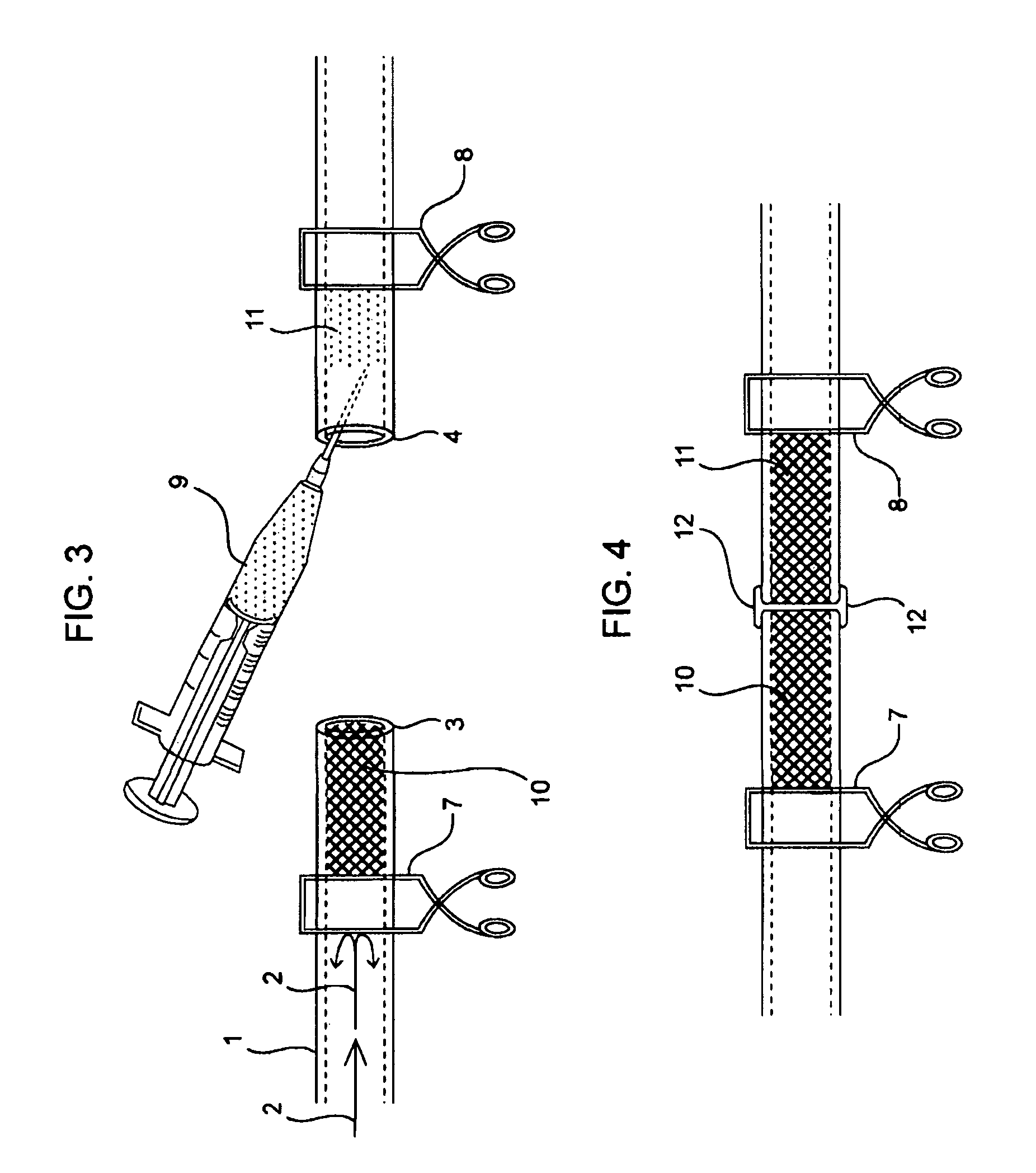Compositions and methods for joining non-conjoined lumens
a technology of non-conjoined lumens and compositions, applied in the field of compositions, methods, and kits for joining together non-conjoined lumens, can solve the problems of long-term stenosis or fibrosis, calcified and diseased vessels providing mechanical challenges, and the geometry of distal portions is stabilized, so as to facilitate the joining
- Summary
- Abstract
- Description
- Claims
- Application Information
AI Technical Summary
Benefits of technology
Problems solved by technology
Method used
Image
Examples
example 1
Preparation and Property Determination of a Sol-Gel Composition of this Invention
[0253]Presented here is a protocol for preparing 100 mL (100 g) of a thermoreversible sol-gel composition having Formulation 1 listed in Table 1.
[0254]Materials:[0255]Phosphate buffered saline (“PBS”): 72 g, pH 7.4, with Ca2+ and Mg2+;[0256]Poloxamer 407 (BASF Pluronic® F 127): 17 g;[0257]Poloxamer 188 (BASF Pluronic® F 68): 11 g.
[0258]Procedure:
[0259]The above materials were mixed at 4° C. under high shear to facilitate dispersing the solid poloxamer in the solvent. The heterogenous mixture is then incubated at 4° C. for 12 hours to allow for complete dissolution of the poloxamer in the solvent. The mixture is then further stirred to ensure homogeneity.
[0260]Compositions having other formulations can be made similarly according to the total concentration of the poloxamers and the ratios of the two poloxamers.
[0261]Water or other aqueous solutions may replace PBS as the solvent. It is preferred that the...
example 2
An Anastomosis Operation Using a Sol-Gel Composition of this Invention
[0263]End to End Anastomosis Surgical Method Performed on Cardiac Tubular Tissues in Rats:
[0264]Rats, which are treated and cared for in accordance with all applicable laws and regulations, and in accordance with good laboratory practices, are anesthetized with isoflurane and prepped in sterile fashion with 70% ethanol. The aorta is exposed and isolated with blunt and sharp dissection through a midline laparotomy incision. The aorta is clamped proximally and distally, and subsequently divided and flushed with heparinized saline. In some cases the rat and a sol-gel composition of Formulation 1 are warmed to about 37° C. with sterile water, and then the sol-gel composition of Formulation 1 is injected into severed aortas in a semi-solid state. In other cases the sol-gel composition of Formulation 1 is injected as a liquid and then heated to about 37° C. with a convectional source to solidify it. After direct reappro...
example 3
Prophetic Example of Using a Sol-Gel Composition in a Vascular Grafting Procedure
[0267]In clinical practice, there are some instances where native vessels (i.e. blood vessels of the patient) are not available for bypass grafting or where, especially for older patients, native fistulas require a long maturation time or do not develop sufficiently. In these instances, physicians may choose to use artificial conduits such as grafts comprising polytetrafluoroethylene (PTFE), which can be formed in reinforced or nonreinforced configurations, for example expended PTFE (ePTFE) grafts, manufactured by Gore and others. Synthetic internal arteriouvenous (AV) fistulas or AV grafts, can be placed in many positions in the arms or legs or across the anterior chest wall.
[0268]The artificial grafts may be used instead of native vessels in all configurations: end-to-end inter-positional grafting, end-to-side for procedures such as artery to vein shunt for dialysis fistula access, end-to-side bypass ...
PUM
| Property | Measurement | Unit |
|---|---|---|
| elastic modulus | aaaaa | aaaaa |
| phase transition temperature | aaaaa | aaaaa |
| ionic strength | aaaaa | aaaaa |
Abstract
Description
Claims
Application Information
 Login to View More
Login to View More - R&D
- Intellectual Property
- Life Sciences
- Materials
- Tech Scout
- Unparalleled Data Quality
- Higher Quality Content
- 60% Fewer Hallucinations
Browse by: Latest US Patents, China's latest patents, Technical Efficacy Thesaurus, Application Domain, Technology Topic, Popular Technical Reports.
© 2025 PatSnap. All rights reserved.Legal|Privacy policy|Modern Slavery Act Transparency Statement|Sitemap|About US| Contact US: help@patsnap.com



